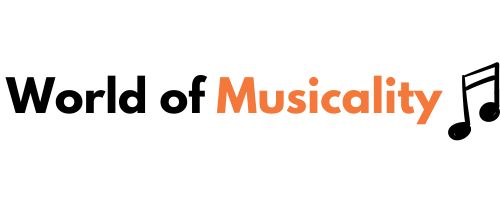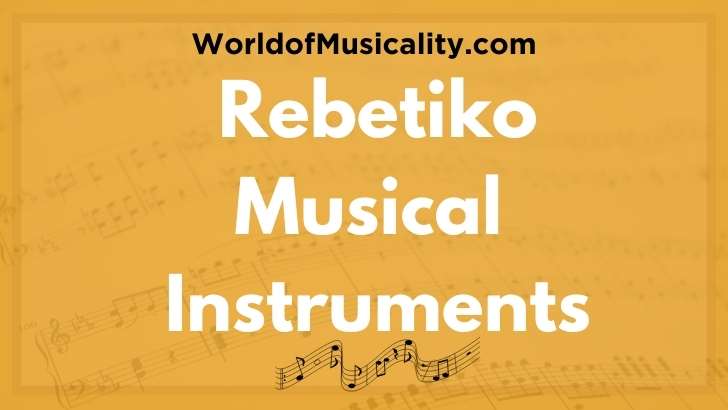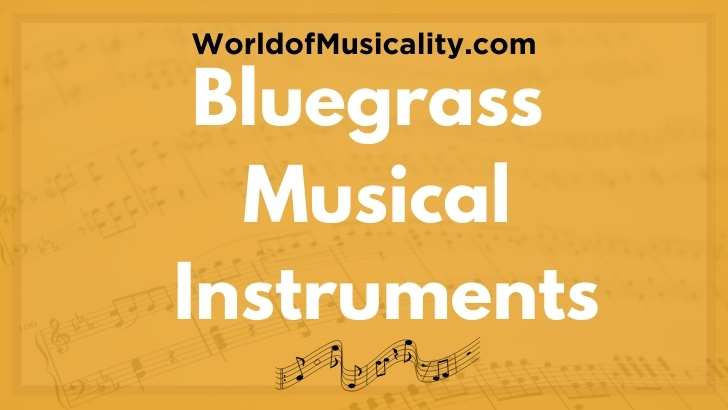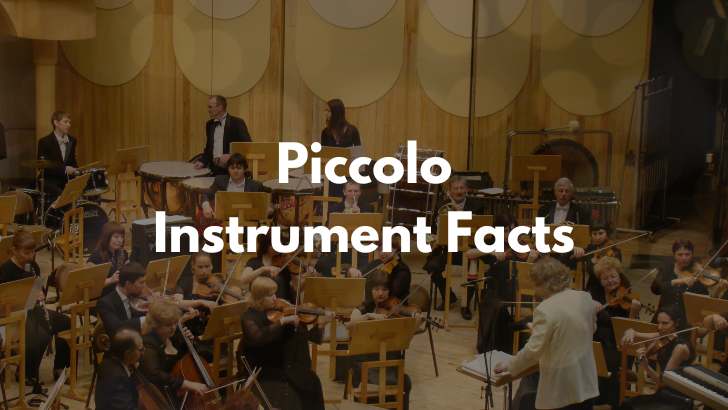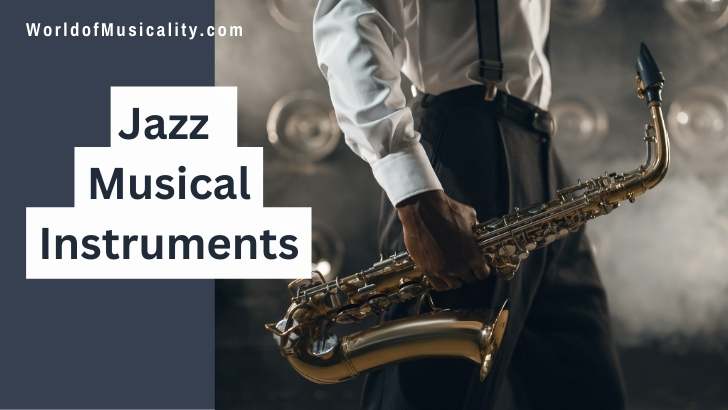
Jazz music is a vibrant and dynamic genre originating in the late 19th and early 20th centuries of the southern United States.
Born from a blend of African rhythms and European musical structures, jazz quickly became a form of musical expression that reflects themes of artistic freedom and musical creativity.
Today, it holds a prestigious place in world music, celebrated for its rich improvisation and complex harmonies.
In this article we will explore a list of ten essential jazz musical instruments that create its unique sound whilst also highlighting some of the more prominent musicians that made these jazz instruments and jazz bands so popular.
Jazz Musical Instrument List
1. Double Bass
Provides the backbone for rhythm and is crucial for jazz ensembles.
The double bass is the largest string instrument in the jazz band, standing about six feet tall. Crafted primarily from wood, such as maple for the back and spruce for the top, its large, hollow body enhances its deep, resonant tones. The double bass has four strings, which are much thicker than those of other string instruments, and it can be played with a bow or by plucking the strings with the fingers, a technique known as “pizzicato.”
In jazz, the double bass serves as the foundational backbone, setting both the rhythm and the harmonic base of the music. Its deep, rich sound helps anchor the ensemble, providing a critical balance to the higher-pitched instruments. The instrument’s role evolved from early 20th-century jazz bands to become a key component in styles like bebop and swing.
One significant musician associated with the double bass is Charles Mingus, a virtuoso player and innovative composer who expanded the possibilities of jazz with his ambitious compositions and dynamic playing style. His contributions have made the double bass a central instrument in jazz music.
2. Guitar
Used in many jazz styles for rhythm and melodic playing.
The guitar, a string instrument cherished in jazz music, combines artistry with engineering to create its melodious sound. Typically crafted from wood such as spruce, maple, or mahogany, the guitar has a broad, hollow body that amplifies the vibrations from its six strings. The strings themselves can be made of nylon or steel, which are plucked or strummed with the fingers or a pick.
In jazz, the guitar entered the spotlight in the 1930s, contributing both rhythm and melody. Its warm, resonant tones make it perfect for creating the smooth, laid-back ambiance characteristic of many jazz pieces. As a versatile instrument, it can deliver everything from sharp, clear single notes to complex chords, making it essential in both solo performances and ensemble pieces.
Significant jazz guitarists include Django Reinhardt, who pioneered the gypsy jazz style, and Wes Montgomery, known for his unique playing technique using the thumb instead of a pick. These musicians expanded the guitar’s role in jazz, exploring new sounds and techniques that continue to influence jazz music today.
3. Saxophone
One of the most iconic jazz instruments, available in various types like alto, tenor, and baritone.
The saxophone, a key instrument in jazz music, stands out with its distinctive curved shape and shiny brass body. Invented in the 1840s by Adolphe Sax, it’s crafted primarily from brass, a metal that contributes to its vibrant and resonant sound. The saxophone is played by blowing air into a mouthpiece fitted with a single reed, which vibrates to produce sound. This setup allows for rich, expressive tones that can convey a wide range of emotions.
In jazz, the saxophone was first adopted in the early 20th century, quickly becoming central to the genre’s development. Its sound is versatile, capable of both powerful blasts and soft, melodic whispers, making it ideal for the dynamic nature of jazz music. The instrument’s role can vary from leading melodies to providing harmonic and rhythmic support within a band.
Prominent jazz saxophonists who have mastered this instrument include Charlie Parker and John Coltrane. Parker revolutionized jazz through his complex solo performances, while Coltrane is celebrated for his profound contributions to jazz improvisation and composition. Their innovative use of the saxophone significantly shaped jazz history.
4. Clarinet
Popular in traditional and swing jazz styles.
The clarinet, a key woodwind instrument in jazz, is crafted primarily from wood, often African blackwood, which is known for its density and ability to produce a warm, rich sound. It consists of a straight cylindrical tube with a flared bell and a mouthpiece fitted with a single reed, which vibrates to produce sound when air is blown through it.
Introduced into jazz in the early 20th century, the clarinet played a vital role during the genre’s formative years, especially in Dixieland and Swing music. Its ability to glide smoothly from low to high notes with expressive dynamics makes it perfect for the intricate melodies and soulful nuances of jazz. The clarinet adds a layer of depth and emotion to jazz ensembles, capable of both standing out as a solo instrument and blending harmoniously with other sounds.
One significant musician associated with the clarinet in jazz is Benny Goodman, known as the “King of Swing.” His virtuoso playing and innovations helped elevate the clarinet to a prominent status in the jazz world, influencing generations of musicians. Goodman’s style and techniques continue to inspire clarinetists in jazz music today.
5. Flute
Occasionally featured in jazz for its light, fluid sound.
The flute, an elegant woodwind instrument, is typically crafted from a variety of materials including metal alloys, silver, gold, or even platinum, enhancing its sleek appearance and the clarity of its sound.
Unlike many woodwinds that use reeds, the flute produces sound when a musician blows air across the opening of the instrument’s headjoint, creating vibrations within its cylindrical body.
In jazz music, the flute was introduced in the early 20th century, adding a distinctive, light texture to the ensemble. Its sound is versatile, capable of both breathy, soft tones and bright, sharp accents, which allows it to weave seamlessly into the complex layers of jazz compositions.
The flute’s role in jazz can range from playing melodic solos to acting as a harmonic filler in larger ensembles.
One significant figure associated with the flute in jazz is Herbie Mann, whose innovation and proficiency helped popularize the instrument in modern jazz styles during the 1950s and 1960s. His work exemplifies the flute’s capability to adapt to and enrich the jazz genre.
6. Trumpet
Known for its powerful and expressive sound, a staple in many jazz pieces.
The trumpet, a brass instrument, is crafted primarily from brass and is often plated with silver or gold for a distinct appearance and sound quality. It features a cylindrical tube that widens into a bell, three valves, and a mouthpiece where the musician blows air to produce sound. The trumpet’s valves, when pressed in combination, alter the pitch by changing the tube’s length through which air travels.
In jazz, the trumpet was integral to the genre’s development in the early 20th century, especially in New Orleans where jazz is said to have born. Its brilliant and piercing sound allows it to stand out in ensembles, making it a favorite for solos. The trumpet’s versatility enables it to convey a range of emotions, from the upbeat blasts of big band music to the soulful expressions in blues.
Legendary musicians like Louis Armstrong and Miles Davis are synonymous with jazz trumpet. Armstrong’s charismatic performances and innovative techniques helped shape jazz’s early style, while Davis’s exploration of modal jazz and other styles expanded the boundaries of jazz music, influencing its evolution profoundly. These artists exemplified how the trumpet could be both a lead and a collaborative voice in jazz music.
7. Trombone
Provides a unique tone and range, used in big band and swing settings.
The trombone is a unique brass instrument known for its long, sliding tube, which the player extends and retracts to change pitches. Constructed primarily from brass, the trombone features a large, flared bell at one end and a mouthpiece at the other. Its distinctive slide mechanism sets it apart from other brass instruments, which typically use valves.
In jazz music, the trombone made its entrance in the early 20th century, becoming a staple in Dixieland bands and later in big band and swing ensembles. The trombone’s deep, resonant sound adds a rich layer of harmony and can also deliver powerful solos. Its ability to glide smoothly between notes—a technique known as legato—enables expressive and soulful performances, making it integral to the emotive quality of jazz.
One significant figure in jazz trombone is J.J. Johnson, known for his technique and influence in modernizing the instrument’s role in jazz. His mastery and innovative approach helped establish the trombone as a solo instrument in bebop jazz, a style characterized by its fast tempos and complex harmonies.
8. Piano
A versatile instrument essential for rhythm, harmony, and solo performances in jazz, classified here due to its mechanism of hammers striking strings.
The piano, a central instrument in jazz music, is both complex and versatile. Technically, it’s categorized as a percussion instrument because it produces sound when small hammers inside strike the strings. These hammers are activated by pressing keys on the piano’s keyboard. The main materials used in its construction include wood for the body and soundboard, metal for the strings and frame, and felt for the hammers.
Jazz pianos are known for their expressive range, capable of producing everything from deep, resonant bass notes to bright, shimmering highs. This range allows the piano to handle rhythm, harmony, and melody, making it indispensable in jazz ensembles. The instrument’s capacity for both solo performances and accompaniment solidifies its role in the genre.
Significant jazz musicians who have mastered the piano include Duke Ellington, whose compositions and performances shaped big band jazz, and Thelonious Monk, known for his distinctive improvisational style. Both artists used the piano to convey complex emotions and innovative musical ideas, greatly influencing jazz music’s development.
9. Drum Set
The heartbeat of a jazz group, crucial for maintaining rhythm and tempo.
The drum set, a pivotal instrument in jazz, is an ensemble of various percussive components, including snare drums, bass drums, tom-toms, hi-hat cymbals, and other cymbals like the ride and crash. These components are typically made from a combination of metal for the cymbals and wood for the drum shells, often layered and treated to enhance sound quality. The drumheads, which produce sound when struck, are usually made from synthetic materials or animal skin.
Introduced into jazz bands in the early 20th century, the drum set quickly became essential. It provides rhythm and tempo, acting as the backbone of a jazz ensemble. The versatility of the drum set allows drummers to create a range of sounds from soft whispers to loud, complex rhythms, adapting to the dynamic flow of jazz music.
Prominent jazz drummers like Gene Krupa, who popularized the full drum set in the 1930s, and Max Roach, known for his innovative approach to using cymbals and rhythmic complexity, have significantly shaped how the drum set is played in jazz. Their contributions have cemented the drum set’s central role in jazz performances and recordings.
10. Vibraphone
A melodic percussion instrument that adds a distinct color to jazz music.
The vibraphone, often simply called the “vibes,” is a captivating percussion instrument in jazz music. It consists of metal bars arranged like the keys of a piano, which are played by striking with mallets. Beneath these bars hang resonator tubes, which amplify the sound, giving the vibes their distinctive, mellow, echoing tone. The bars are usually made of aluminum, contributing to the instrument’s clear, shimmering sound.
Introduced to jazz in the early 20th century, the vibraphone adds a soft and almost magical sound to jazz compositions. It’s particularly noted for its sustained tones, which are controlled by a pedal similar to that on a piano. This pedal allows musicians to let the notes ring out or stop them abruptly, offering dynamic flexibility in performances.
Prominent in the world of jazz vibraphone players was Lionel Hampton, who is considered one of the pioneers in introducing the vibraphone into jazz. His energetic playing style and creativity helped establish the vibraphone as a standard instrument in jazz ensembles, allowing it to play both harmonic and rhythmic roles in the music. Hampton’s contributions to jazz were significant, influencing generations of vibraphonists and jazz musicians alike.
Now that we’ve explored this fascinating list of jazz musical instruments, we would highly encourage you to delve deeper into the world jazz music and the amazing instruments that underpin it. Your exploration might just be the start of a lifelong passion for this captivating music style.
If you would like to learn more about the extensive world of musical instruments, visit our homepage at worldofmusiclality.com or click the links below to explore the rest of our site.
